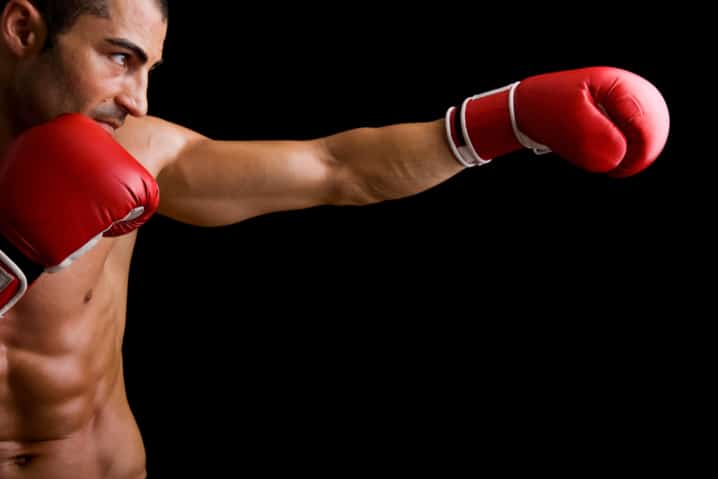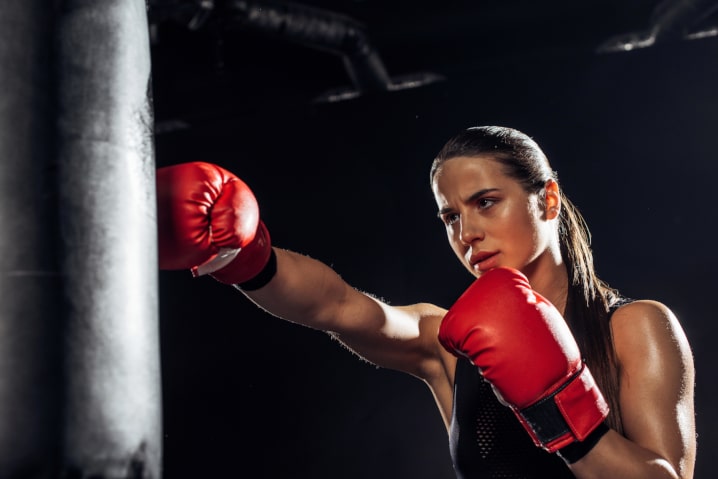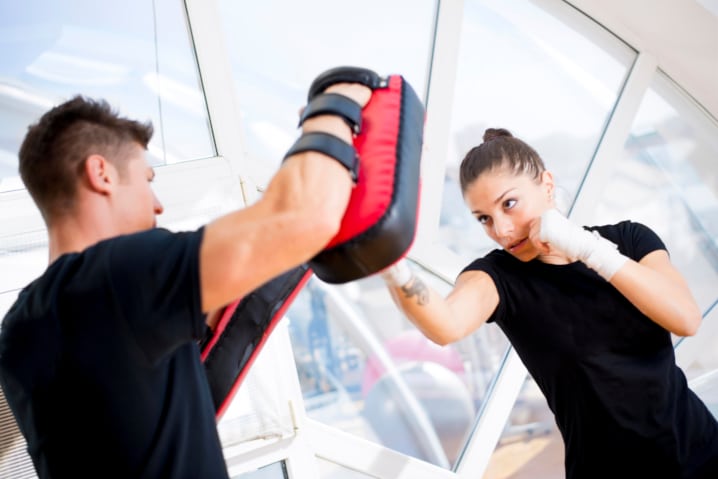Boxing is a high-calorie-burning workout, with over 700 calories burned in an hour on the bag, mitts, or in the ring. It’s a top-notch cardio option, especially when paired with a healthy lifestyle. Visible improvements can be seen after just a week of training. Beyond fitness benefits, boxing skills can be crucial for self-defense in challenging situations, potentially even saving your life.

The Benefits of Boxing Training
- Improved cardiovascular health. The quick movements of footwork and punching in boxing can increase your heart rate and strengthen your heart. And they will work your lungs and make your blood vessels function well.
- Powerful muscles, bones, and joints. Although you won’t gain bigger muscles in boxing than in weightlifting, you’ll have powerful muscles that can make you quicker in movement than an average Joe. Boxing can strengthen your bones and joints. And your hands will get used to the hard impact.
- Full-body workout. The workouts in boxing will include the whole body. And they are excellent for cardio and resistance training.
- Stress relief. Like any tough workout, boxing helps relieve stress and anxiety. And it promotes good sleep.
- Weight control. Burning that many calories in just one session, expect to burn stubborn fats in a brief period.
- Improved hand-eye coordination. As you build up in boxing, you will improve your hand-eye coordination. This training will let you hit your target with power and precision, giving you improved hand-eye control while you learn how to guard yourself at the same time.
- Improved confidence. Your newfound abilities and success in boxing will improve your brainpower. And it will give you the confidence to take on tough challenges in life.
- Improved core stability. Boxing workouts strengthen the core: the part of your body that runs from the mid-thigh all the way to your neck. This is essential in delivering a powerful punch.
- Improved endurance. Boxers need to run at a constant pace for at least 30 minutes. This will help improve your endurance and boost your power and quickness even when you’re tired.
- Self Defense. If you can punch quicker than an average person and you know how to block and dodge punches, you can subdue an opponent in no time. The fact is, an attacker may stop challenging you the first time he feels your punch and sees that he can’t take it.

Complete Amateur Boxing Program
A retired professional boxer, skilled both in and out of the ring, has developed a full program for novice boxers. This program can be utilized at home or in the gym, under the guidance of a knowledgeable boxing partner. Your trainer has the option to enhance this program during your boxing sessions.
While you might not finish these routines in your initial session, gradually incorporate one exercise at a time as you advance until you can finish the workout.
Boxing Equipment
This boxing workout will need the following equipment:
- Punching Bag
- Punch Mitts (if you have a trainer who can assist you)
- Boxing Gloves
- Boxing Hand Wraps
- Protective Gear (for sparring sessions)
Warm-up Exercises
- 6 counts inhale and exhale
- 16 counts head bending (front and side positions)
- 16 counts neck rotation (clockwise and counter-clockwise)
- Arms stretching
- Arms rotation
- 16 counts body bending (left and right)
- 16 counts body bending (front and back)
- 16 counts hip rotation (clockwise and counter-clockwise)
- 16 counts half bending
- 16 counts full bending
- 16 counts knee rotation (clockwise and counter-clockwise)
- 16 counts toe rotation (clockwise and counter-clockwise)
- 16 counts jumping jacks
The Boxing Workout
- 3-minute footwork exercise
- Basic punches (20 counts left jab, 20 counts right straight punch, 20 counts jab and straight punches, 20 counts uppercut left and right, 20 counts left hook, 20 counts right hook)
- Punch combination (20 counts left jab, right straight, left hook, right straight)
- Punch combination (20 counts left jab, left uppercut, right straight)
- Punch combination (20 counts left jab, right uppercut, left hook, right straight)
- Punch combination (20 counts left jab, left uppercut, left hook, right straight)
- Punch combination (20 counts left jab, right straight, right uppercut, right straight)
Cool-Down Exercises
- Loosening exercise with handshake and footwork combination
- Abdominal exercises
- Push up exercises
Note: All boxers are required to jog every morning for 60 minutes.

Proper Punching Position and Delivery
To pack a strong punch, utilize your entire body to enhance the impact of each punch type, like jabs, uppercuts, hooks, or straight punches. Ensure your arm remains relaxed and is backed by torso and hip rotation before making contact with the target.
As a right-handed boxer (orthodox), you typically lead with your left foot and fist. Conversely, as a left-handed boxer (southpaw), you usually lead with your right foot and fist.
How to Throw a Jab

A jab is used to distract the opponent, making him lose concentration and balance. And you can use the jab to keep your opponent at bay, preventing him from closing in on you. This punch is so effective; boxers use it to conceal the straight punch (the power punch).
Instruction: Deliver a jab by putting most of your body weight on your lead foot, relaxing your whole punching arm, and then delivering the jab by slightly rotating your torso and hips clockwise. The fist rotates 90 degrees before impact, targeting the chin. Make sure your rear hand remains next to your face, guarding your jaw.
How to Throw a Straight Punch
A straight punch is done with your power hand (your rear hand).
Instruction: Deliver a straight punch by putting most of your body weight on your lead foot with your rear foot standing slightly on your toes, relax your whole punching arm, then deliver the punch by rotating your torso, hips, and toes counter-clockwise to support the full extension of your arm while fist rotates 90 degrees before impact targeting the chin. Make sure your lead hand remains next to your face, guarding your jaw.
How to Throw an Uppercut

An uppercut is used to target either the chin or the torso. Throw an uppercut when you’re very close to your opponent.
Instruction: Deliver an uppercut by putting most of your body weight on your lead foot. From the guard position, shift the torso slightly to the right, drop the punching hand below the opponent’s chest while slightly bending your knees, then deliver the uppercut by thrusting the rear hand upwards (with palm facing up) and knees also pushing upward. The lead hand may remain next to your face, guarding your jaw.
How to Throw a Hook
When thrown at perfect timing, a hook can be a punch your opponent won’t see because a hook is a semi-circular punch thrown to the side of the opponent’s head.
Instruction: From the guard position, draw back your elbow with a horizontal fist (with palm facing down), then rotate your torso and hips clockwise, shifting your body weight to your rear foot while throwing your hook and pivoting your lead foot clockwise before impact. Make sure your rear hand remains next to your face, guarding your jaw, because it’s very vulnerable when you throw a hook.
Note: Most boxers prefer speed over power. Although you need to include power punches in your training. Aside from the fact that you can deliver lightning punches in just seconds, you will develop power in those speed punches, given the correct execution of every punch.
(This content was created with the help of AI.)
